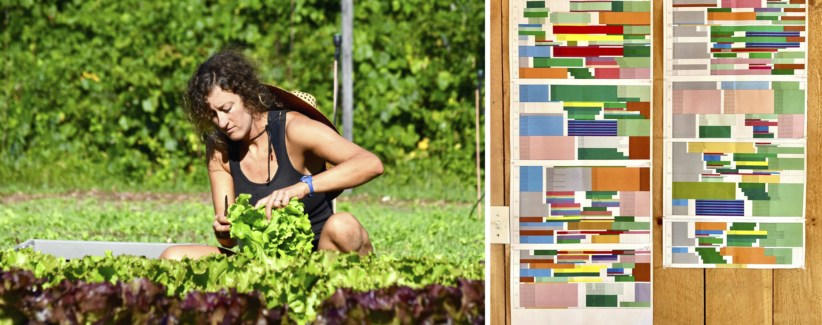The Season of Planning

I am excited to share with you my crop planning process, which brings me boundless joy during these colder months. Winter provides a time for a slower pace, and dreaming about the growth of the next season!
Crop planning is a complex process that involves both artistic and scientific approaches, especially because we work the land without using a tractor to till the soil. At Gaining Ground, we grow intensively, with several successions of crops per bed each growing season, which makes the planning process more challenging. For example, we grow on three acres of land at the farm, but in reality we cultivate over six acres because we plant in the same bed space at least twice over the course of the growing season. We strategically make the crop plan during the calm winter months when we are able to think clearly and craft a guide for our summer selves who will hustle to put the plan into action.
Here are some of the variables we all have to consider when we grow food:
What do people want to eat? We can grow over 70 different kinds of vegetables in New England. There are numerous varieties of each crop to choose from with varying flavor, texture, color, size, shape, heat tolerance, disease resistance, and the list goes on!
What is the climate and microclimate of the land? What is our USDA Plant Hardiness Zone? What soil type do we have? What are the intricacies of the land? Where are there wet spots, slopes, cold areas, south-facing exposures, and shaded areas?
What are our time and space requirements? How much land do we have? Do we have the ability to start seedlings in a greenhouse? Do we have access to any covered growing spaces like high or low tunnels?
How do we manage crop rotations? How are we balancing nutrients? What did we grow previously and where? Are there certain pest or disease cycles that need to be broken? How are we incorporating diverse root systems to benefit the soils of the farm?

The first step in the planning process is to review last year’s plan and to look at our partner feedback surveys. I like to sit down with the farm crew in November to discuss what generally worked well and what didn’t and what varieties we liked or didn’t like, to determine if the quantity of vegetables was appropriate, and to think about new crops and varieties that might be exciting to try. We review the greenhouse schedule and the timing of the seedlings in the greenhouse as well as the days they require in the field. This can easily take a full day and is a great way to reflect upon the work of the season.
Since Gaining Ground has been growing for 28 years now, we have an established plan that we work from each year. We are not reinventing the wheel each season, but making small changes that improve upon our growing practices, better serve our partners, and allow for volunteers of all ages and abilities to participate in the implementation process of farming.
After we go through our review process, it’s time to create the field planting schedule, which details the timing, quantity, and varieties of each crop we plant. The schedule also specifies whether each crop will be direct seeded into the soil or started in the greenhouse. I go through each week of the growing season, beginning March 1st and ending November 7th, and lay out the plan.
Once the field planting schedule is made, we begin mapping out the plantings to the beds in our fields starting with large plant families and heavy nutrient feeders like onions, leeks, broccoli and cabbage, butternut squash, tomatoes, and cucumbers. This is a very time-consuming process because all of these elements have to fit together in space and time. It can feel like working on a huge jigsaw puzzle. I often do this task sitting by the fireplace. It’s the most challenging part of planning but also very fun!

Once the big plant families are set, I feather in the faster-growing crops like cutting greens, lettuces, and radishes. Finally, once I have found homes for all the vegetables, I make a plan for cover crops so that we can add more diverse root systems to the soil that will be able to scavenge for nutrients and give back to the community underground.
When the maps are complete, I then create the greenhouse schedule, adding another layer of timings and detailed planning.
These are some of the many important variables we consider and processes we undertake when making our crop plan at Gaining Ground. With this work done, we set the coming season up for success!